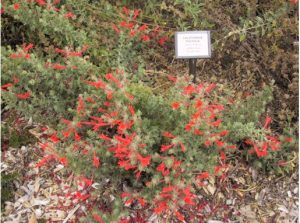Most gardeners in our beautiful Mother Lode country experience some type of challenge. Whether it’s poor soil, harsh weather, wildlife or pests, we need to find ways to increase our chances of success. One important factor that is easy to overlook is simply choosing the right plants. As the saying goes, use “the right plant in the right place.” Choosing plants that are tried and true can certainly decrease our frustration factor.
That’s why I was excited to discover the beautiful UC Davis Arboretum and teaching nursery. Generally, an Arboretum is a place where plants are cultivated for scientific and educational purposes. The recent studies at the UC Davis Arboretum have focused on natural pest control methods, DNA analysis, susceptibility to diseases, plant-insect interactions and the wildlife in the Arboretum.
The Arboretum at UC Davis is considered a “living museum”, occupies 100 acres, is open to the public every day of the year and best of all, admission is free! They have spectacular collections of specimens including 22,000 trees and plants adapted to a Mediterranean climate (hot, dry summers and cool, wet winters). It runs along the peaceful banks of Putah Creek. The plants are arranged in a series of gardens that represent different geographic areas, plant groups or horticultural themes. Some of the expansive collections where you can wander and even have a picnic are:
• Conifer, Acacia, Redwood, Redbud and Oak groves
• Desert, East Asian, Australian, Southwest USA, South American and North Coast collections
• California Foothill Collection
• White flower garden and a terrace garden
• The Ruth Risdon Storer Garden, containing many “Arboretum All-Star” plants
The “All-Stars” project was created in order to help the public make eco-friendly plant choices. To my amazement, they have made life easier for us by identifying 100 tough and reliable plants. The original All-Star list was created by the UC Davis horticultural staff. Then each plant was tested in the Arboretum and put through field trials (including those done by California Master Gardeners). The final list was then narrowed down; each plant had to have the following features:
• Be attractive for most of the year
• Thrive in California’s Mediterranean climate
• Successfully test in the UC Davis Arboretum
• And also, as much as possible, be low maintenance, drought tolerant and/or attractive to beneficial wildlife and pollinator insects.
I was able to “meet” and drool over some of the more unique All-Stars at the nursery. Of course, that got me reaching deep into my wallet to take home my favorites. Just from my personal successes in my years of gardening, here is my top ten on the All-Star list. To see the complete list of All-Stars, go here.
• California white sage (Salvia apiana) – tall California native shrub with attractive grey foliage and white spring flowers; attracts pollinating bees
• autumn sage (Salvia greggii ‘ flame’) – bright red/magenta blossoms and a hummingbird magnet (I also love the red and white bi-colored ‘lipstick’)
• salvia Sierra San Antonio (Salvia jamensis (x) ‘Sierra San Antonio’) – a beautiful and unusual yellow and peach bicolor
• California fuchsia – (Epilobium canum) – bright orange California native that is easy to grow; not the most attractive shrub but hummingbirds absolutely love it
• hybrid catmint (Nepeta x faasseni) – tough and low-growing plant with delicate lavender-blue flowers; attracts butterflies and other pollinators
• Saint Catherine’s lace (Eriogonum giganteum) – California’s largest buckwheat; woolly grey foliage with white flower clusters; attracts numerous beneficial insects
• Wayne Roderick seaside daisy (Erigeron ‘W.R.’) – long blooming daisy with large lavender blooms; butterflies and beneficial insects like it
• Iceberg® rose (Rosa ‘Korbin’) – disease resistant and needs a lot less care than many roses; can be trained into standard or climbing form
• dwarf plumbago (Ceratostigma plumbaginoides) – groundcover with clusters of intense blue flowers; spreads easily once it comes back in the spring
• Goodwin Creek lavender (Lavandula x ginginsii ‘Goodwin Creek Grey’) – more heat resistant than English lavenders; attracts bees, hummingbirds and beneficial insects
So if you want to see a remarkable display of trees, shrubs and perennials, take the drive to the Arboretum and teaching nursery at the UC Davis campus. It’s well worth the time, especially if you plan your trip around the spring or fall plant sale. For more information and excellent links to gardening references, plant sale dates, irrigation and climate zone trials and the calendar of events (including guided tours and folk music jams), go here. The website includes the All-Stars plant database – you can even download the Arboretum All-Stars booklet that has detailed information on each plant. You can also contact them at (530) 752-4880 or email: arboretum@ucdavis.edu.
Kathy Nunes has found that gardening in the foothills is different than gardening in the Bay Area; she plants natives to help solve some of her gardening challenges.


